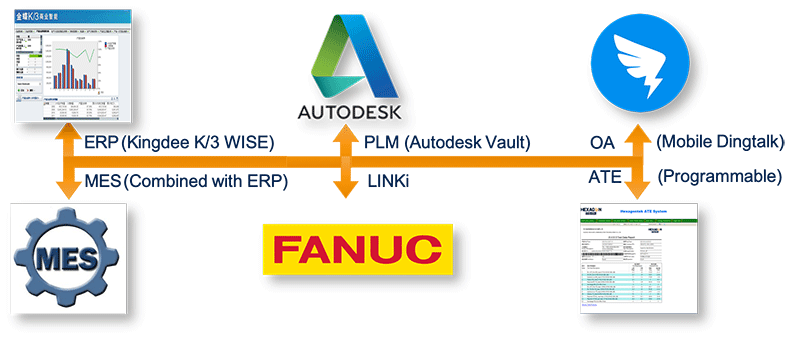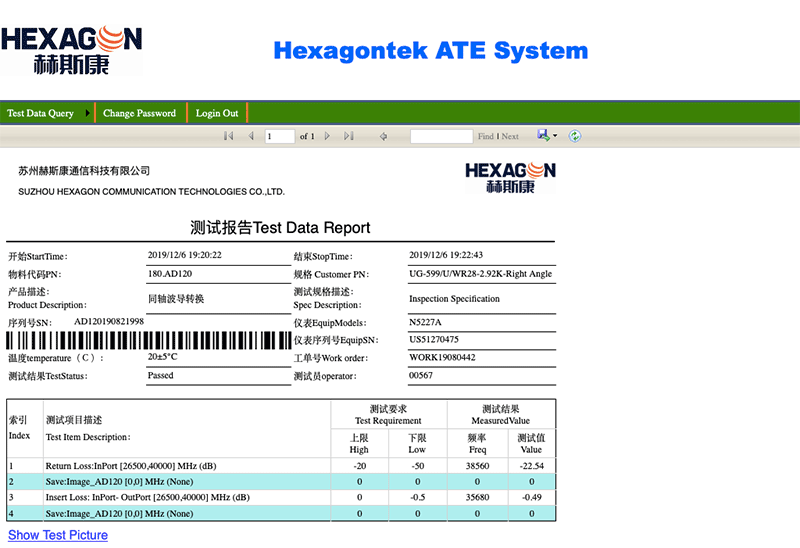INFORMATION

Up-to-date Management System
The modern enterprise management model and idea are used to our plant management. At present, ERP, PLM, MES, ATE, MT-LINKi, etc. systems have been introduced for the purpose of networked, digitalized, and intelligent management, which makes our management and production much more efficient and shortens the lead time. It is a significant guarantee for the timely delivery of orders.

ERP (Enterprise Resource Planning), based on thoughts of systematic management, is built on the basis of information technology and provides a management platform of decision-making for the decision-makers and common employees. The function of ERP includes accounting, financial management, production control and management, supply chain management, purchasing management, distribution management, inventory control and HR management. It can effectively reduce operating costs and business risk, reduce production costs and improve on-time delivery rate.
PLM (Product Lifecycle Management), is the process of managing the entire lifecycle of a product from inception, through engineering design and manufacture, to service and disposal of manufactured products. PLM integrates people, data, processes and business systems and provides a product information backbone for companies and their extended enterprise.
Documented benefits of product lifecycle management include:
✪ Reduced time to market
✪ Increase full price sales
✪ Improved product quality and reliability
✪ Reduced prototyping costs
✪ More accurate and timely request for quote generation
✪ Ability to quickly identify potential sales opportunities and revenue contributions
✪ Savings through the re-use of original data
✪ A framework for product optimization
✪ Reduced waste
✪ Savings through the complete integration of engineering workflows
✪ Documentation that can assist in proving compliance for RoHS or Title 21 CFR Part 11
✪ Ability to provide contract manufacturers with access to a centralized product record
✪ Seasonal fluctuation management
✪ Improved forecasting to reduce material costs
✪ Maximize supply chain collaboration
ATE (Automatic Test Equipment) is any apparatus that performs tests on a device, known as the DUT (Device Under Test), EUT (Equipment Under Test) or UUT (Unit Under Test), using automation to quickly perform measurements and evaluate the test results. An ATE can be a simple computer controlled network analyzer in S parameters test, or a complicated system containing dozens of complex test instruments (signal generators, power meters, multipliers and switching matrix etc.) capable of automatically testing and diagnosing faults in PIM (Passive Intermodulation) test or power handling test. ATE can obviously improve test efficiency and accuracy, especially for the devices with multiple ports (combiners, POIs and OCUs etc.)
Hexagon ATE system support testing as below:
✪ S Parameter Test
✪ PIM Test
✪ Sealing Test
✪ Temperature Test (High Temperature and Low Temperature)
✪ Vibration Test

MES (Manufacturing Execution Systems) are computerized systems used in manufacturing. MES track and document the transformation of raw materials through finished goods. MES can provide the right information at the right time and show the manufacturing decision maker "how the current conditions on the plant floor can be optimized to improve production output." MES work in real time to enable the control of multiple elements of the production process (e.g. inputs, personnel, machines and support services).
"Manufacturing Execution Systems create flawless manufacturing processes and provide real-time feedback of requirement changes," and provide information at a single source. Other benefits from successful MES implementation might include:
✪ Reduced waste, re-work and scrap, including quicker setup times
✪ More accurate capture of cost-information (e.g. labor, scrap, downtime, and tooling)
✪ Increased uptime
✪ Incorporate Paperless Workflow Activities
✪ Reduced inventory, through the eradication of just-in-case inventory
MT-LINKi, is a PC software that connects the machines in the factory by Ethernet, and it collects, manages and makes to visible various information of the machine. It can realize visualization of machinery in the factory and contribute to improvement of operation rate.
✪ It is possible to collect machine information from not only machine tools with FANUC CNC but also FANUC robot controller, and PLCs supporting OPC UA communication and machine tools supporting MTConnect communication.
✪ By using the Ethernet I/O converter, it is also possible to collect information on existing equipment without Ethernet I/F.
✪ Many standard screens for displaying the operating status of the machine and the performance record of the machine are prepared.
✪ By using in combination with SERVO VIEWER, it is possible to collect servo data and visualize machine operation is also possible.


PLM (Product Lifecycle Management), is the process of managing the entire lifecycle of a product from inception, through engineering design and manufacture, to service and disposal of manufactured products. PLM integrates people, data, processes and business systems and provides a product information backbone for companies and their extended enterprise.
Documented benefits of product lifecycle management include:
✪ Reduced time to market
✪ Increase full price sales
✪ Improved product quality and reliability
✪ Reduced prototyping costs
✪ More accurate and timely request for quote generation
✪ Ability to quickly identify potential sales opportunities and revenue contributions
✪ Savings through the re-use of original data
✪ A framework for product optimization
✪ Reduced waste
✪ Savings through the complete integration of engineering workflows
✪ Documentation that can assist in proving compliance for RoHS or Title 21 CFR Part 11
✪ Ability to provide contract manufacturers with access to a centralized product record
✪ Seasonal fluctuation management
✪ Improved forecasting to reduce material costs
✪ Maximize supply chain collaboration
ATE (Automatic Test Equipment) is any apparatus that performs tests on a device, known as the DUT (Device Under Test), EUT (Equipment Under Test) or UUT (Unit Under Test), using automation to quickly perform measurements and evaluate the test results. An ATE can be a simple computer controlled network analyzer in S parameters test, or a complicated system containing dozens of complex test instruments (signal generators, power meters, multipliers and switching matrix etc.) capable of automatically testing and diagnosing faults in PIM (Passive Intermodulation) test or power handling test. ATE can obviously improve test efficiency and accuracy, especially for the devices with multiple ports (combiners, POIs and OCUs etc.)
Hexagon ATE system support testing as below:
✪ S Parameter Test
✪ PIM Test
✪ Sealing Test
✪ Temperature Test (High Temperature and Low Temperature)
✪ Vibration Test

✪ Reduced waste, re-work and scrap, including quicker setup times
✪ More accurate capture of cost-information (e.g. labor, scrap, downtime, and tooling)
✪ Increased uptime
✪ Incorporate Paperless Workflow Activities
✪ Reduced inventory, through the eradication of just-in-case inventory
MT-LINKi, is a PC software that connects the machines in the factory by Ethernet, and it collects, manages and makes to visible various information of the machine. It can realize visualization of machinery in the factory and contribute to improvement of operation rate.
✪ It is possible to collect machine information from not only machine tools with FANUC CNC but also FANUC robot controller, and PLCs supporting OPC UA communication and machine tools supporting MTConnect communication.
✪ By using the Ethernet I/O converter, it is also possible to collect information on existing equipment without Ethernet I/F.
✪ Many standard screens for displaying the operating status of the machine and the performance record of the machine are prepared.
✪ By using in combination with SERVO VIEWER, it is possible to collect servo data and visualize machine operation is also possible.
